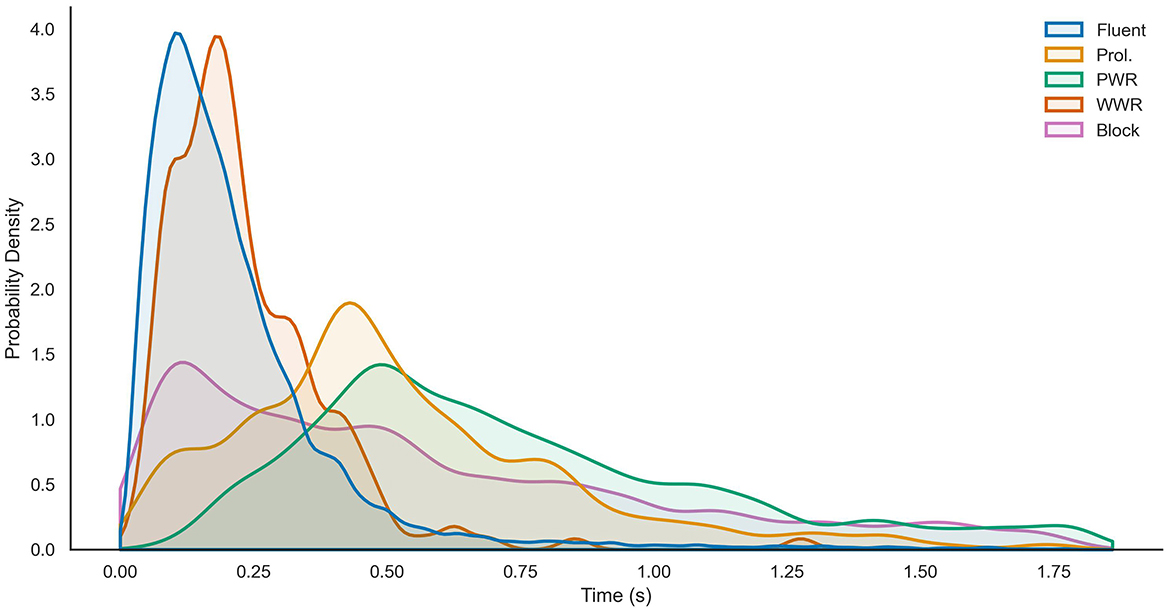
94% of researchers rate our articles as excellent or good
Learn more about the work of our research integrity team to safeguard the quality of each article we publish.
Find out more
CORRECTION article
Front. Psychol., 06 November 2024
Sec. Psychology of Language
Volume 15 - 2024 | https://doi.org/10.3389/fpsyg.2024.1507956
This article is a correction to:
Comparison of performance of automatic recognizers for stutters in speech trained with event or interval markers
A Corrigendum on
Comparison of performance of automatic recognizers for stutters in speech trained with event or interval markers
by Barrett, L., Tang, K., and Howell, P. (2024). Front. Psychol. 15:1155285. doi: 10.3389/fpsyg.2024.1155285
In the published article, there was an error in Figure 3. The figure was supposed to include data for a type of stuttered speech (Prolongations or “Prol.”). The corrected Figure 3 and its caption appear below.

Figure 3. Gaussian kernel density estimates of the relative frequencies of event lengths split by speech class from the UCLASS Event subset. X-axis gives event length in seconds and the Y-axis shows probability. Reproduced with permission from Barrett (2024).
The authors apologize for this error and state that this does not change the scientific conclusions of the article in any way. The original article has been updated.
All claims expressed in this article are solely those of the authors and do not necessarily represent those of their affiliated organizations, or those of the publisher, the editors and the reviewers. Any product that may be evaluated in this article, or claim that may be made by its manufacturer, is not guaranteed or endorsed by the publisher.
Keywords: stuttering, speech pathology, automatic speech recognition, machine learning, computational paralinguistics, language diversity, language model, whisper
Citation: Barrett L, Tang K and Howell P (2024) Corrigendum: Comparison of performance of automatic recognizers for stutters in speech trained with event or interval markers. Front. Psychol. 15:1507956. doi: 10.3389/fpsyg.2024.1507956
Received: 08 October 2024; Accepted: 25 October 2024;
Published: 06 November 2024.
Edited and reviewed by: Laura M. Morett, University of Missouri, United States
Copyright © 2024 Barrett, Tang and Howell. This is an open-access article distributed under the terms of the Creative Commons Attribution License (CC BY). The use, distribution or reproduction in other forums is permitted, provided the original author(s) and the copyright owner(s) are credited and that the original publication in this journal is cited, in accordance with accepted academic practice. No use, distribution or reproduction is permitted which does not comply with these terms.
*Correspondence: Peter Howell, cC5ob3dlbGxAdWNsLmFjLnVr
Disclaimer: All claims expressed in this article are solely those of the authors and do not necessarily represent those of their affiliated organizations, or those of the publisher, the editors and the reviewers. Any product that may be evaluated in this article or claim that may be made by its manufacturer is not guaranteed or endorsed by the publisher.
Research integrity at Frontiers

Learn more about the work of our research integrity team to safeguard the quality of each article we publish.